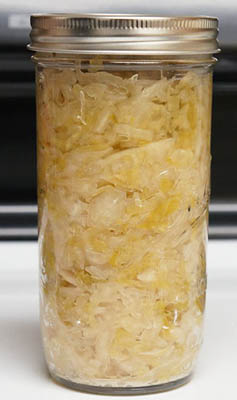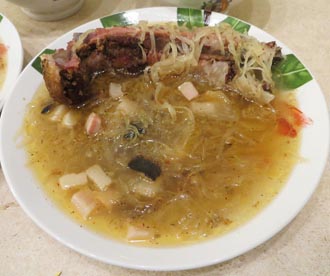Sauerkraut Nutrition Facts
Sauerkraut is a traditional fermented cabbage dish that originated in Central and Eastern Europe. The name "sauerkraut" comes from the German words "sauer," meaning sour, and "kraut," meaning cabbage. It is made by finely shredding cabbage and fermenting it using lactic acid bacteria.
Sauerkraut has a tangy and sour flavor and is often used as a condiment or ingredient in various dishes.
 |
| Sauerkraut. Courtesy: ccbarr |
Process of making sauerkraut
Choose fresh, firm heads of cabbage for making sauerkraut. Remove any damaged or wilted outer leaves.
Remove the core from the cabbage and finely shred the leaves. You can use a knife, mandoline slicer, or a food processor with a shredding blade. Aim for thin, uniform shreds.
Place the shredded cabbage in a large bowl or fermentation vessel and add salt. The salt helps draw out moisture from the cabbage and inhibits the growth of undesirable bacteria.
Using clean hands, massage and squeeze the cabbage to break down its cell walls and release more moisture. Pack the cabbage tightly into a clean fermentation vessel or jar.
The cabbage should be completely covered by brine to prevent mold or spoilage.
Cover the vessel or jar with a clean cloth or lid that allows gases to escape. Ferment the cabbage at room temperature, away from direct sunlight. Generally, sauerkraut is fermented for 1-4 weeks. The longer it ferments, the sourer it becomes.
During fermentation, a layer of foam or scum may form on the surface. Skim off any mold or scum that forms.
Once the sauerkraut has reached the desired flavor, remove the weight and transfer it to a clean, airtight jar or container. Store it in the refrigerator to slow down the fermentation process. Properly stored sauerkraut can last for several months.
Remember to practice good hygiene throughout the process by using clean utensils, containers, and hands.
Health benefits of Sauerkraut
Sauerkraut, which is fermented cabbage, offers several potential health benefits due to its unique composition and fermentation process.
Low in calories and fat: Sauerkraut is relatively low in calories (40 calories/3.5 oz) and fat, making it a suitable option for those watching their weight or looking to add flavor to their meals without adding excessive calories.
Probiotic properties: Sauerkraut is a natural source of beneficial bacteria, including Lactobacillus bacteria, which are probiotics. Probiotics promote a healthy gut microbiome, aiding digestion and supporting immune function.
Improved digestion: The fermentation process involved in making sauerkraut helps break down the cabbage, making it easier to digest. Additionally, the probiotics in sauerkraut can help balance the gut flora and alleviate digestive issues such as bloating and constipation.
Enhanced nutrient absorption: The fermentation process of sauerkraut enhances the bioavailability of certain nutrients, making them easier for the body to absorb. These nutrients include vitamins C and K, as well as various minerals.
Antioxidant activity: Sauerkraut contains antioxidants, such as flavonoids, which help protect the body's cells from damage caused by harmful free radicals. Antioxidants play a role in reducing the risk of chronic diseases and supporting overall health.
Potential cancer-fighting properties: Some studies suggest that the fermentation process involved in making sauerkraut produces compounds called isothiocyanates, which have shown anticancer properties in lab studies. However, more research is needed to understand their effects on humans.
Caution: It is important to note that sauerkraut is often high in sodium due to the brining process. If you are watching your sodium intake, you may want to consume it in moderation or look for low-sodium options. Additionally, individuals with certain health conditions, such as high blood pressure or kidney problems, should be cautious about their sodium intake and consult with a healthcare professional if needed.
| Principle | Nutrient Value | Percent of RDA |
|---|---|---|
| Energy | 40 Kcal | 2% |
| Carbohydrates | 4.16 g | 3.2% |
| Protein | 0.9 g | <2% |
| Total Fat | 0.14 g | <1% |
| Cholesterol | 0 mg | 0% |
| Dietary Fiber | 2.9 g | 7.6% |
| Vitamins | ||
| Folates | 24 µg | 6% |
| Niacin | 0.143 mg | <1% |
| Pantothenic acid | 0.093 mg | 2% |
| Pyridoxine | 0.013 mg | 1% |
| Riboflavin | 0.022 mg | 1.7% |
| Thiamin | 0.021 mg | 2% |
| Vitamin A | 18 IU | <1% |
| Vitamin C | 14.7 mg | 16% |
| Vitamin E | 0.14 mg | 1% |
| Vitamin K | 14 μg | 11.5% |
| Electrolytes | ||
| Sodium | 659 mg | 44% |
| Potassium | 170 mg | 3.6% |
| Minerals | ||
| Calcium | 30 mg | 3% |
| Iron | 1.47 mg | 18% |
| Magnesium | 13 mg | 3% |
| Manganese | 0.151 mg | 6.5% |
| Phosphorus | 20 mg | 3% |
| Zinc | 0.19 mg | 1.7% |
| Phyto-nutrients | ||
| Carotene-β | 8 µg | -- |
| Crypto-xanthin-ß | 0 µg | -- |
| Lutein-zeaxanthin | 295 µg | -- |
Buying
Traditionally, sauerkraut is made with cabbage, salt, and water. Some commercial varieties may also include spices or other vegetables.
Sauerkraut can vary in taste and texture, ranging from mild to tangy and from crunchy to softer. Consider your personal preference and experiment with different brands and varieties to find the one you enjoy the most.
Fresh sauerkraut will have a vibrant color and crisp texture. Avoid sauerkraut that looks discolored, mushy, or has a foul smell, as these are signs of spoilage. Also, avoid that has additives, preservatives, or excessive amounts of salt.
Storing
Sauerkraut is a fermented food that demands proper storage is essential to maintain its flavor and quality. It is preferable to store sauerkraut in glass jars or containers. Transfer the sauerkraut to an airtight container or jar and make sure it is fully submerged in its liquid (brine). This will help preserve its freshness and prevent it from drying out. Store it in the refrigerator at a temperature below 40°F (4°C).
It's a good practice to label the container with the date of preparation. This allows you to keep track of its freshness and ensures you use it within a reasonable time frame.
When stored properly in the refrigerator, sauerkraut can last for several months, maintaining its flavor and quality. However, over time, it may continue to ferment and develop a stronger sour taste.
Remember to use clean utensils and avoid cross-contamination when removing sauerkraut from the container to prevent spoilage. If you notice any signs of mold, off odors, or sliminess, discard the sauerkraut as it may indicate spoilage.
Food uses
Sauerkraut has a tangy and sour flavor and is often used as a condiment or ingredient in various dishes.
 |
| Sauerkraut soup (Kapuśniak). Courtesy: Varchar N |
Sauerkraut has a tangy and sour flavor and is often used as a condiment or ingredient in various dishes. Here are some popular uses of sauerkraut in food:
Sandwiches and Wraps: Sauerkraut adds a tangy and crunchy element to sandwiches and wraps. It is commonly used in Reuben sandwiches, which typically include corned beef, Swiss cheese, Russian dressing, and sauerkraut on rye bread.
Sausages and Hot Dogs: Sauerkraut is a classic topping for sausages and hot dogs. It provides a tart and zesty contrast to the savory flavors of the meat.
Stews and Casseroles: Sauerkraut can be added to stews and casseroles to impart a unique flavor. It works well with ingredients like potatoes, carrotse, and meats such as pork or sausage.
Soups: Sauerkraut can be used as an ingredient in soups, particularly in Eastern European cuisine. It adds a sour and tangy note to the soup base and complements the other ingredients.
Salads: Sauerkraut can be incorporated into salads for added texture and flavor. It pairs well with ingredients like apples, bacon, and cheese.
Pierogies and Dumplings: Sauerkraut can be used as a filling for pierogies (Eastern European dumplings) or added to dumpling fillings. It provides a delicious contrast to the dough and other ingredients.
Side Dish: Sauerkraut can be served as a side dish alongside meats, such as roast pork or sausages. It can be warmed up or served cold, depending on personal preference.
Sauces and Dressings: Sauerkraut can be blended or pureed and used as a base for sauces or dressings. It adds a unique tanginess to the flavor profile.
Safety profile
Sauerkraut has been consumed for centuries and is generally considered safe for most people when consumed in moderation.
Foodborne Illness: Like any fermented food, sauerkraut can be susceptible to contamination if not prepared, stored, or handled properly.
Sodium Content: Sauerkraut is often salted during the fermentation process. As a result, sauerkraut can be relatively high in sodium. Individuals on a low-sodium diet or with specific health conditions, such as hypertension, should be mindful of their sauerkraut intake.
Gas and Digestive Issues: Some individuals may experience gas, bloating, or other digestive discomfort when consuming sauerkraut, particularly if they have a sensitive digestive system or underlying digestive conditions.
Interaction with Medications: Certain medications, such as blood thinners or immunosuppressants, may interact with fermented foods due to their high vitamin K content or potential for microbial activity.
(Medical Disclaimer: The information and reference guides on this website are intended solely for the general information of the reader. It is not to be used to diagnose health problems or for treatment purposes. It is not a substitute for medical care provided by a licensed and qualified health professional. Please consult your health care provider for any advice on medications.)
Read further on..
≺≺ How Can I Get Rid of Pain Naturally?
≺≺-Back to Cabbage from Sauerkraut.
≺≺-Back to Home page.
Further Resources:
Understanding and making Sauerkraut. (pdf, opens in new window).
USDA National Nutrient data base (opens in new window).
Health benefits of sauerkraut -BBC good food. (opens in new window).